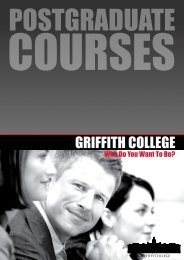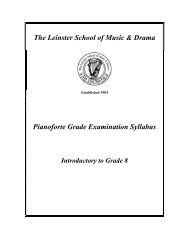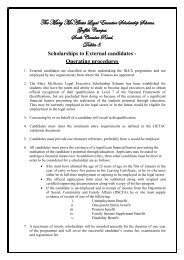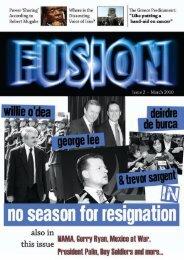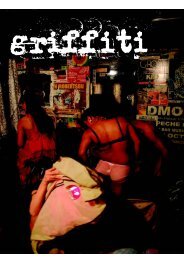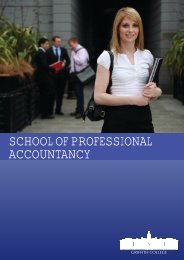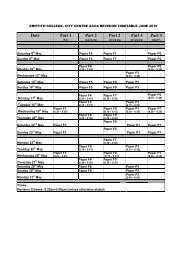Violin - Piano Syllabus - KEI
Violin - Piano Syllabus - KEI
Violin - Piano Syllabus - KEI
You also want an ePaper? Increase the reach of your titles
YUMPU automatically turns print PDFs into web optimized ePapers that Google loves.
The Leinster School ofMusic & DramaEstablished 1904<strong>Violin</strong>GradeExaminations<strong>Syllabus</strong>
The Leinster School of Music & Drama<strong>Violin</strong> Grade Examinations <strong>Syllabus</strong>ContentsThe Leinster School of Music & Drama ____________________________ 2General Information & Examination Regulations ____________________ 4Primary ____________________________________________________ 6Preparatory _________________________________________________ 8Grade 1 ____________________________________________________ 10Grade 2 ____________________________________________________ 12Grade 3 ____________________________________________________ 14Grade 4 ____________________________________________________ 16Grade 5 ____________________________________________________ 18Grade 6 ____________________________________________________ 20Grade 7 ____________________________________________________ 22Grade 8 ____________________________________________________ 24Junior & Senior Repertoire ______________________________________ 26Examples for Scales & Arpeggios_________________________________ 271
The Leinster School of Music & Drama<strong>Violin</strong> Grade Examinations <strong>Syllabus</strong>The Leinster School ofMusic & DramaEstablished 1904"She beckoned to him with her second fingerlike one preparing a certificate in pianoforte...at the Leinster School of Music."Samuel BeckettEstablished in 1904 The Leinster School of Music & Drama is now celebrating its centenaryyear. Its long-standing tradition both as a centre for learning and examining is stronger thanever.TUITIONExpert individual tuition is offered in a variety of subjects:• Singing and Vocal Coaching• Drama and Communication• Keyboard• Woodwind• StringsExperienced and dedicated teachers provide excellent tuition to pupils of all ages and levels.The emphasis is on learning through enjoyment, and while exams are encouraged they arenot compulsory.EXAMINATIONSAs a national examining body the School offers grade and diploma examinations in bothmusic and drama. Almost 700 teachers nationwide are teaching the School's varioussyllabuses and preparing students for Leinster School examinations throughout the year,Approximately 14,000 candidates are examined annually - thus the reputation of the Schoolreaches far beyond the city in which it began almost a century ago.2
The Leinster School of Music & Drama<strong>Violin</strong> Grade Examinations <strong>Syllabus</strong>HISTORYThe School was founded in 1904 by Samuel Myerscough, an acclaimed musician, teacherand examiner. Even in the School’s infancy students travelled from throughout Ireland toattend lessons. The Musical Herald of 1 July 1909 wrote at length of Mr Myerscough’sprominence in Irish musical life:“The work by which Mr. Myerscough will be best remembered is the LeinsterSchool of Music, of which he is the founder and inspiring force. …. Pupilscame from as far north as Enniskillen, southwards from Waterford, andacross from Galway.”This tradition continues to the present day, with students travelling from as far as Derry andDonegal, and from Cork and Kerry.The School's original teaching staff included Madame Quinton Rosse, Madame CoslettHeller and esteemed piano tutors Patricia Read and May Cosgrave. The hard work anddedication of the staff ensured the reputation of the School went from strength to strength.According to the Irish Art Handbook of 1949 the School had “become one of the mostimportant influences on the musical life of the country as a teaching, examining body.”The Leinster School’s original location on Harcourt Street was followed by a move to UpperStephen Street in 1982. In September 1998 a further move was made to its present locationon Griffith College’s seven acre campus, where students can avail of college facilitiesincluding free car parking, a bar and restaurant, and a library.Students past and present are prominent performers both at national and international level,with many appearing at the National Concert Hall and venues throughout Ireland, and manyothers employed by orchestras and opera companies around the globe. Many of the currentteaching staff are also firmly established in the performance arena. This experience,combined with their depth of teaching knowledge enhances the unique learning experienceoffered by the School.3
The Leinster School of Music & Drama<strong>Violin</strong> Grade Examinations <strong>Syllabus</strong>General Information & Examination Regulations1. The examination syllabus has been framed on modern and educational lines, and on a systematic basisof progression through the grades from primary to Diploma.2. Schedule of maximum marks for all Grades:Scales & Arpeggios 15Sight-Reading 10Ear Tests 10Theory 5Piece 1 20Piece 2 20Piece 3 / Studies* 20Total 100* In Primary & Preparatory three pieces are presented for examination; in Grades 1-8 two pieces & onegroup of studies are presented.3. The grade examinations are marked out of 100. Candidates must secure 85 marks for a first classhonours; 80 marks for honours; 75 marks for a pass with merit; and 65 marks for a pass.4. A medal will be awarded to candidates gaining 95 marks in grades from preparatory to Grade 8.5. In all examinations, prepared pieces may be heard in full or in part at the discretion of the examiners.6. The examiners in their marking will pay attention not only to accuracy of notes and time, but also to otherthings inherent in a good performance, for example, choice of tempo, observance of marks of expression,rhythm and phrasing.7. The candidate’s selection of music, to reflect a varied and interesting programme, will be taken intoaccount.8. The editions listed in this syllabus are suggested editions. Alternative editions of similar standing areequally as acceptable.9. Accurate tuning of the instrument, volume, clarity and quality of tone, posture and hand positions will allbe taken into account in the marking of pieces and studies, scales and arpeggios.10. Scales and arpeggios must be played from memory, at a pace appropriate to the technical demands ofthe Grade. In all Grades scales and arpeggios should be played legato, and without undue accentuation.11. Candidates should have acquired some skill in vibrato by Grade 5.12. Candidates in all Grades must tune their own instruments. The examiner should not be expected to dothis.13. Candidates should provide themselves with a music stand if required.4
The Leinster School of Music & Drama<strong>Violin</strong> Grade Examinations <strong>Syllabus</strong>14. The candidate and the teacher must accept the decision of the examiners regarding each candidateunconditionally.15. The right is reserved to refuse or cancel any entry in which case the examination fee will be returned.16. Examinations are held annually at local centres throughout Ireland.17. Entry forms, with particulars filled in and accompanied by fees, must reach The Leinster School of Music& Drama by November 1 st , for examinations to be held before the Christmas period; February 1 st , forexaminations to be held before the Easter period; and March 1 st , for examinations to be held after theEaster period.18. Any school or teacher presenting at least twenty candidates for examination in any one subject maysecure a local centre for that subject. Those presenting fewer than twenty candidates may obtain a centreby paying the equivalent to the fees of twenty candidates, or alternatively can send their candidates to thenearest existing centre.19. Fees are fixed on the assumption that the venue for examination will be provided by the school or teacher.20. If through illness a candidate is unable to attend the examination at the appointed time, re-entry will beallowed for the same grade on payment of a transfer fee of €3, or for a higher grade on payment of thedifference in fees plus a transfer fee of €3. Candidates who have been in contact with an infectious illnessmust not be presented for examinations unless they are out of quarantine.21. Heads of schools or centres are requested to ensure that the room assigned for the examinations hassatisfactory heat and light, and that a suitable piano or a digital piano is provided for the examination.22. Please allow 3-4 weeks for the processing of exam results, especially at busy times of the year. We doour best to expedite all results on a first come, first served basis, but exams held after mid-May may nothave results returned before the end of the school year. Responsibility is not accepted for loss of markcards after dispatch by post. Where cards have been lost, the total marks obtained, but not their details,will be supplied on application.5
The Leinster School of Music & Drama<strong>Violin</strong> Grade Examinations <strong>Syllabus</strong>Primary GradeSchedule of maximum marksScales & Arpeggios 15Sight-Reading 10Scales & ArpeggiosEar Tests 10Theory 5Pieces 1 20Scales: G major, D major 2 1 octave 203 20Play as even notes, whole bowsArpeggios: G major, D major 1 octavePlay as even notes, whole bowsSight-ReadingAny note from G below middle C to open E, fourth space.Ear Tests1. To clap or tap the rhythm of a simple two bar melody. The example will be played twice by theexaminer.2. To sing, whistle or hum a short rhythmical phrase (major only). The example will be played twice by theexaminer within the range of doh - soh. The tonic and tonic triad will be sounded before each playing.TheoryCandidates are required to know the stave, treble clef signs, barlines, bars, note values and any otherinformation relevant to the pieces played, e.g. the Italian terms and signs used.6
The Leinster School of Music & Drama<strong>Violin</strong> Grade Examinations <strong>Syllabus</strong>PiecesChoose any three pieces from the following list for performance.The pieces chosen should be of contrasting style to reflect a varied and interesting programme.1. Waltz Time Adam Carsefrom Fiddler’s Nursery (Stainer & Bell)2. Free from Care Adam Carsefrom Fiddler’s Nursery (Stainer & Bell)3. Butterflies Katherine & Hugh Colledgefrom Waggon Wheels (Boosey & Hawkes)4. Hills & Dales Katherine & Hugh Colledgefrom Waggon Wheels (Boosey & Hawkes)5. Westminster Abbey Katherine & Hugh Colledgefrom Waggon Wheels (Boosey & Hawkes)6. Mary had a Little Lamb & Puppet on a String arr. Paul de Keyserfrom <strong>Violin</strong> Playtime Book 1 (Faber)7. Old Macdonald arr. Paul de Keyserfrom <strong>Violin</strong> Playtime Book 1 (Faber)8. Hush, Little Baby arr. Paul de Keyserfrom <strong>Violin</strong> Playtime Book 1 (Faber)9. Blues Song Hilary Burgoynefrom Take the Stage (Boosey & Hawkes)10. The Skater’s Waltz Emil Waldteufelfrom Making the Grade, Grade 1 (Chester)7
The Leinster School of Music & Drama<strong>Violin</strong> Grade Examinations <strong>Syllabus</strong>Preparatory GradeScales & ArpeggiosSchedule of maximum marksScales & Arpeggios 15Sight-Reading 10Ear Tests 10Theory 5Pieces 1 202 203 20Scales: G major 2 octavesD major, A major, C major1 octavePlay as even notes, whole bowsArpeggios: G major 2 octavesD major, A major, C major1 octavePlay as even notes, whole bowsSight-ReadingA piece of c.8 bars duration in the key of D, in simple time, using basic note values, from open G to fourthfinger B on top string.Ear Tests1. To clap along as soon possible with the pulse of a short piece played by the examiner which will not beplayed more than three times. To state whether the fragment is in 2 or 3 time.2. To sing, whistle or hum a short rhythmical phrase (major only). The example will be played twice by theexaminer within the range of doh - soh. The tonic and tonic triad will be sounded before each playing.TheoryCandidates are required to answer simple questions relating to the prepared pieces with reference tomarkings such as slurs, ties, staccato, accent marks, sharps and flats, and Italian terms & signs.8
The Leinster School of Music & Drama<strong>Violin</strong> Grade Examinations <strong>Syllabus</strong>PiecesChoose any three pieces from the following list for performance.The pieces chosen should be of contrasting style to reflect a varied and interesting programme.1. Alouette Traditional French Canadianfrom Folk Fiddle Playtime (Faber)2. Early One Morning Traditional Englishfrom Folk Fiddle Playtime (Faber)3. Eeensy, Weensy Spider Traditional Americanfrom Making the Grade, Grade 1 (Chester)4. Canon Johann Pachelbelfrom The Classic Experience for <strong>Violin</strong> & <strong>Piano</strong> (Cramer)5. Ladushki Nikolai Rimsky-Korsakovfrom Folk Fiddle Playtime (Faber)6. Edelweiss Richard Rodgersfrom Making the Grade, Grade 1 (Chester)7. Jean de Florette Jean-Claude Petitfrom Making the Grade, Grade 1 (Chester)8. At Dawn Adam Carsefrom Fiddler’s Nursery (Stainer & Bell)9. Afloat Adam Carsefrom Fiddler’s Nursery (Stainer & Bell)11. Fiddlesticks Katherine & Hugh Colledgefrom Waggon Wheels (Boosey & Hawkes)12. Bow Ties Katherine & Hugh Colledgefrom Waggon Wheels (Boosey & Hawkes)13. Tap Dance Hilary Burgoynefrom Take the Stage (Boosey & Hawkes)9
The Leinster School of Music & Drama<strong>Violin</strong> Grade Examinations <strong>Syllabus</strong>Grade 1Scales & ArpeggiosSchedule of maximum marksScales & Arpeggios 15Sight-Reading 10Ear Tests 10Theory 5Studies 20Pieces 1 202 20Scales: G major, A major 2 octavesD major, C major, F major1 octavePlay separate and slurred one beat to a bow (see p.27, example 1)Arpeggios: G major, A major 2 octavesD major, C major, F major1 octavePlay even notes, whole bowsSight-ReadingA piece of c.8 bars duration in the key of D, G or C, in simple time, using basic note values.Ear Tests1. To clap the rhythm of a short phrase. The example will be played twice by the examiner.2. To clap from sight a four bar rhythm which may include crotchets, minims and dotted minims.3. To clap along as soon possible with the pulse of a short piece played by the examiner which will not beplayed more than three times. To state whether the fragment is in 2 or 3 time.4. To sing, whistle or hum a short rhythmical phrase (major only). The example will be played twice by theexaminer. The tonic and tonic triad will be sounded before each playing.TheoryCandidates will be expected to answer questions relating to the prepared pieces regarding note and restvalues, simple time signatures and key signatures of required scales.1 0
The Leinster School of Music & Drama<strong>Violin</strong> Grade Examinations <strong>Syllabus</strong>StudiesChoose one from the following list:Preliminary Exercises, Adam Carse (Stainer & Bell)1. Section 4, No.2, 5 & 72. Section 5, No.1, 5 & 73. Section 6, No.9, 10 & 12<strong>Violin</strong> Playtime Studies, Paul de Keyser (Faber)4. No.195. No.30PiecesChoose any two pieces from the following list for performance.The pieces chosen should be of contrasting style to reflect a varied and interesting programme.1. The Yellow Rose of Texas Traditional Americanfrom Making the Grade, Grade 1 (Chester)2. Ploughman’s Song Giovanni Gabriellifrom First Solo Pieces for <strong>Violin</strong> and <strong>Piano</strong> (Schott)3. Rigaudon Jean-Philippe Rameaufrom Young <strong>Violin</strong>ist’s Repertoire Book 1 (Faber)4. March Georg Frideric Handelfrom Judas Maccabaeus from Young <strong>Violin</strong>ist’s Repertoire Book 1 (Faber)5. Folk Song Johannes Brahmsfrom First Solo Pieces for <strong>Violin</strong> and <strong>Piano</strong> (Schott)6. No.1 Edward Elgarfrom Six Easy Pieces, Op.22 (Bosworth)7. Dance No.8 Béla Bartókfrom For Children Vol.2, arr. Zarthureczky (Editio Musica)8. The Irish Washerwoman arr. Sheila Nelsonfrom Technitunes (Boosey & Hawkes)9. Waltz Mc Kayfrom Four Modern Dance Tunes10. Fiddler on the Roof Jerry Block & SheldonHarrickfrom Making the Grade, Grade 1 (Chester)11. The Phantom of the Opera Andrew Lloyd Webberfrom Making the Grade, Grade 1 (Chester)12. We All Stand Together Paul Mc Cartneyfrom Making the Grade, Grade 1, arr. Jerry Lanning (Chester)1 1
The Leinster School of Music & Drama<strong>Violin</strong> Grade Examinations <strong>Syllabus</strong>Grade 2Scales & ArpeggiosSchedule of maximum marksScales & Arpeggios 15Sight-Reading 10Ear Tests 10Theory 5Studies 20Pieces 1 202 20Scales: G major, A major, B flat major 2 octavesD major1 octaveA minor, E minor (harmonic or melodic)1 octavePlay separate and slurred one beat to a bow (see p.27, example 1)Arpeggios: G major, A major, B flat major 2 octavesD major1 octaveA minor, E minor1 octavePlay even notes, whole bowsSight-ReadingA piece of c.8 bars duration in the key of C or F, in simple time, using basic note values.Ear Tests1. To clap a four bar rhythm in simple 2, 3, 4 and compound duple time, and to state the time signature. Theexample will be played twice by the examiner.2. To clap from sight a four bar rhythm that may include quavers, crotchets, minims, dotted-minims, crotchetand minim rests.3. To sing, whistle or hum a two or three bar phrase played in a major or minor key. The example will beplayed twice by the examiner. The tonic and tonic triad will be sounded before each playing.4. To recognise any interval from a major 2 nd , major 3 rd , minor 3 rd , perfect 4 th and perfect 5 th . The example willbe played twice by the examiner. The tonic will be sounded before each playing.TheoryKey signatures (in correct order), time signatures, terms and signs with regards to prepared pieces.Construction of the major and minor scale.1 2
The Leinster School of Music & Drama<strong>Violin</strong> Grade Examinations <strong>Syllabus</strong>StudiesChoose one from the following list:New School of <strong>Violin</strong> Studies, Book 1, Adam Carse (Stainer & Bell)1. No.22. No.53. No.64. No.10<strong>Violin</strong> Study Time, Paul de Keyser (Faber)5. No.156. No.16 & 20PiecesChoose any two pieces from the following list for performance.The pieces chosen should be of contrasting style to reflect a varied and interesting programme.1. Hora Traditional Russianfrom <strong>Violin</strong> Playtime Book 3 (Faber)2. Andante Christoph Willibald Gluckfrom The Library of <strong>Violin</strong> Classics (Amsco)3. No.2 & 3 Carl Philipp Emanuel Bachfrom Three Little Pieces, Chester String Series Vol. 2 (Chester)4. Two German Dances No. 2 Wolfgang Amadeus Mozartfrom Chester String Series Vol. 1 arr. Peggy Radmall (Chester)5. Minuet in G Ludwig van Beethovenfrom The Library of <strong>Violin</strong> Classics (Amsco)6. No.3 Edward Elgarfrom Six Easy Pieces, Op.22 (Bosworth)7. Adagio Aram Khachaturianfrom The Classic Experience for <strong>Violin</strong> & <strong>Piano</strong> (Cramer)8. Galop Dmitri Kabalevskyfrom <strong>Violin</strong> Playtime Book 3 (Faber)9. Andante Ferdinand Kuchlerfrom Concertino in G (Bosworth)10. Fly Away Christopher Nortonfrom Microjazz for <strong>Violin</strong> (Boosey & Hawkes)11. Castle on a Cloud Claude-Michel Schönbergfrom Making the Grade, Grade 2 (Chester)14. Cakewalk Katherine & Hugh Colledgefrom Shooting Stars (Boosey & Hawkes)1 3
The Leinster School of Music & Drama<strong>Violin</strong> Grade Examinations <strong>Syllabus</strong>Grade 3Scales & ArpeggiosSchedule of maximum marksScales & Arpeggios 15Sight-Reading 10Ear Tests 10Theory 5Studies 20Pieces 1 202 20Scales: G major, A major, D major, B flat major 2 octavesF major1 octaveG minor, D minor, A minor (harmonic or melodic)2 octavesPlay (1) separate bows and (2) slurred two beats to a bow (see p.27, example 2)Chromatic Scales: Starting on open strings G, D & A 1 octavePlay separate bowsArpeggios: G major, A major, D major, B flat major 2 octavesF major1 octaveG minor, D minor, A minor2 octavesPlay even notes, whole bowsSight-ReadingA piece of Preparatory standard.Ear Tests1. To clap a four bar rhythm played in simple or compound time, and to state the time signature. Theexample will be played twice by the examiner.2. To clap from sight a four bar rhythm that may include quavers, crotchets, minims, dotted minims,semibreves and their rests.3. To sing, whistle or hum a melodic phrase beginning and ending on the key note. The example will beplayed twice by the examiner. The tonic and tonic triad will be sounded before each playing.4. To recognise intervals from the major scale and to include a minor 3 rd . The example will be played twiceby the examiner. The tonic will be sounded before each playing.TheoryKey signatures (in correct order), time signatures terms and signs with regards to prepared pieces.1 4
The Leinster School of Music & Drama<strong>Violin</strong> Grade Examinations <strong>Syllabus</strong>StudiesChoose one from the following list:New School of <strong>Violin</strong> Studies, Book 3, Adam Carse (Stainer & Bell)1. No.52. No.113. No.74. No.85. No.9<strong>Violin</strong> Study Time, Paul de Keyser (Faber)6. No.227. No.298. No.30PiecesChoose any two pieces from the following list for performance.The pieces chosen should be of contrasting style to reflect a varied and interesting programme.1. Gavotte Jean-Philippe Rameaufrom Chester String Series Vol.2 (Chester)2. Gavotte in D Johann Sebastian Bach(Schott)3. 2 nd or 3 rd movement Oskar Riedingfrom Concertino in B minor, Op.35 (Bosworth)4. In the Hall of the Mountain King Edvard Griegfrom What Else Can I Play? <strong>Violin</strong> Grade Four (IMP)5. Summertime George Gershwin & IraGershwinfrom Making the Grade, Grade 3 (Chester)6. I Got Rhythm George Gershwin & IraGershwinfrom What Else Can I Play? <strong>Violin</strong> Grade Four (IMP)7. Leierkasten Dmitri Shostakovichfrom Albumstücke (Peters)8. Mazurka Nathalia Baklanovafrom Young <strong>Violin</strong>ist’s Repertoire Book 3 (Faber)9. Snow Dance Christopher Nortonfrom Microjazz for <strong>Violin</strong> (Boosey & Hawkes)10. Gavotte & Irish Jig Mc Kayfrom A Tuneful Introduction to Third Position15. Cossacks Katherine & Hugh Colledgefrom Shooting Stars (Boosey & Hawkes)1 5
The Leinster School of Music & Drama<strong>Violin</strong> Grade Examinations <strong>Syllabus</strong>Grade 4Scales & ArpeggiosSchedule of maximum marksScales & Arpeggios 15Sight-Reading 10Ear Tests 10Theory 5Studies 20Pieces 1 202 20Scales: B flat major, B major, C major, D major, G major, A mjor 2 octavesA minor, B minor, C minor, D minor (harmonic or melodic) 2 octavesPlay (1) separate bows (2) slurred two beats to a bow (see p.27, example 2)Chromatic Scales: Starting on first finger on G, D & A strings, 1 octavePlay separate bowsArpeggios: B flat major, B major, C major, D major, G major, A mjor 2 octavesA minor, B minor, C minor, D minor2 octavesPlay (1) even notes, whole bows (2) slurred three notes to a bow (see p.27, ex. 3)Sight-ReadingA piece of Grade 1 standard.Ear Tests1. To clap a four bar rhythm played in simple or compound time, and to state the time signature. Theexample will be played twice by the examiner.2. To clap from sight a four bar rhythm that may include quavers, crotchets, minims, dotted minims,semibreves and their rests.3. To sing, whistle or hum the top or bottom note of an interval (to include all major, perfect and minor 3rdsand minor 6ths). The example will be played twice by the examiner. The tonic will be sounded before eachplaying.4. Observation test on a short piece played by the examiner. Questions will be selected beforehand and mayinclude tempo, tempo changes, dynamics and gradations of tone.TheoryKey signatures of required scales and terms and signs. All simple and compound time signatures.1 6
The Leinster School of Music & Drama<strong>Violin</strong> Grade Examinations <strong>Syllabus</strong>StudiesChoose one from the following list:New School of <strong>Violin</strong> Studies, Book 3, Adam Carse (Stainer & Bell)1. No.17 & 182. No.203. No.21Forty Selected Studies, Op.36 Bk.1 , Jacques Mazas (Schirmer)4. No.35. No.6PiecesChoose any two pieces from the following list for performance.The pieces chosen should be of contrasting style to reflect a varied and interesting programme.1. 4 th movement Arcangelo Corellifrom Sonata in E, Op.5 No.112. 1 st movement Antonio Vivaldifrom Sonata in F minor, Op.2 No.103. 1 st & 2 nd movements Georg Frideric Handelfrom Sonata in E (Peters)4. The Swan Camille Saint-Saënsfrom Carnival of the Animals from The Library of <strong>Violin</strong> Classics (Amsco)5. Pizzicato Léo Delibesfrom Sylvia from The Library of <strong>Violin</strong> Classics (Amsco)6. 3 rd movement Bohuslav Martinůfrom Sonatina (Editio Supraphon)7. Tanz Dmitri Shostakovichfrom Albumstücke (Peters)8. Chanson Louis XIII et Pavane in the style of Louis Couperin Fritz Kreisler(Schott)9. 2 nd & 3 rd movements Ferdinand Kuchlerfrom Concertino in D, Op.15 (Bosworth)10. Wind Up Christopher Nortonfrom Microjazz for <strong>Violin</strong> (Boosey & Hawkes)11. Millionaire’s Hoedown Herman Clebanofffrom Solos for Young <strong>Violin</strong>ists Volume 2 (Summy-Birchard)1 7
The Leinster School of Music & Drama<strong>Violin</strong> Grade Examinations <strong>Syllabus</strong>Grade 5Scales & ArpeggiosSchedule of maximum marksScales & Arpeggios 15Sight-Reading 10Ear Tests 10Theory 5Studies 20Pieces 1 202 20Scales: A flat major, E flat major, E major 2 octavesG major, A major3 octavesG# minor, B minor, C minor, E minor (harmonic or melodic) 2 octavesPlay separate bows & slurred, seven notes to a bow (see p.27, ex. 4A, 4B & 4C)Arpeggios: A flat major, E flat major, E major 2 octavesG major, A major3 octavesG# minor, B minor, C minor, E minor 2 octavesPlay separate bows & slurred, three notes to a bow (see p.27, example 3)Dominant Sevenths: Key of C starting on G resolving on the tonic 1 octaveKey of G starting on D resolving on the tonic1 octaveSeparate bows & slurred four notes to a bowDiminished Sevenths: On G & D 1 octaveSeparate bows & slurred four notes to a bowSight-ReadingA piece of Grade 2 standard.Ear Tests1. To clap a four bar rhythm of suitable standard and to state the time signature. The example will be playedtwice by the examiner.2. To clap from sight a four bar phrase of suitable standard.3. To sing, whistle or hum a short melody played twice by the examiner.4. Observation test on a short piece played by the examiner. Questions will be selected beforehand and mayinclude tempo, tempo changes, articulation, dynamics and gradations of tone.TheoryTo recognise terms and signs and any ornaments within the pieces played. Regarding prepared pieces, keysignatures with knowledge of their relative minor or majors.1 8
The Leinster School of Music & Drama<strong>Violin</strong> Grade Examinations <strong>Syllabus</strong>StudiesChoose one from the following list:Forty Selected Studies, Op.36 Bk.1, Jacques Mazas (Schirmer)1. No.132. No.153. No.184. No.30PiecesChoose any two pieces from the following list for performance.The pieces chosen should be of contrasting style to reflect a varied and interesting programme.1. Preludio & Allegro Arcangelo Corellifrom Baroque <strong>Violin</strong> Pieces Book 3 (Associated Board)2. Gigue Marin Marais7 th movement from Sonata a la Maresienne (Schott)3. Largo Antonio Vivaldifrom “Winter” (The Four Seasons) from Baroque <strong>Violin</strong>ist, ed. Nelson (Boosey & Hawkes)4. Sicilienne Maria Theresia von Paradisarr. Samuel Dushkin (Schott)5. Menuetto & Trio Franz Schubertfrom Sonatina in G minor, No.3 from Three Sonatinas Op.137 (Peters)6. Melody in F Anton Rubinsteinfrom The Library of <strong>Violin</strong> Classics (Amsco)7. Valse Antonin DvořákOp.54 No.4, arr, Kolman (Universal)8. Serenade Espagnole Aleksandr Glazunowarr. Fritz Kreisler (Schott)9. The Lark in the Clear Air arr. T.C. Kellyfrom Irish Tunes arranged for <strong>Violin</strong> and Keyboard, Volume 2 (Ossian)10. Two Planxties T. O’Carolan arr. T.C. Kellyfrom Irish Tunes arranged for <strong>Violin</strong> and Keyboard, Volume 2 (Ossian)1 9
The Leinster School of Music & Drama<strong>Violin</strong> Grade Examinations <strong>Syllabus</strong>Grade 6Scales & ArpeggiosSchedule of maximum marksScales & Arpeggios 15Sight-Reading 10Ear Tests 10Theory 5Studies 20Pieces 1 202 20Scales: D flat major, E flat major, F major 2 octavesG major, D major3 octavesC# minor, D minor, F# minor (harmonic and melodic) 2 octavesG minor, A minor (harmonic and melodic)3 octavesPlay separate bows & slurred, seven notes to a bow (see p.27, ex. 4A, 4B &4C)Chromatic Scales: Starting on A flat, B & C 2 octavesPlay separate bows & slurred, four notes to a bowArpeggios: D flat major, E flat major, F major 2 octavesG major, D major3 octavesC# minor, D minor, F# minor 2 octavesG minor, A minor3 octavesPlay separate bows & slurred, three notes to a bow (see p.27, example 3)Dominant Sevenths: Key of C starting on G resolving on the tonic 2 octavesKey of D starting on A resolving on the tonic2 octavesPlay separate bows & slurred, four notes to a bowDiminished Sevenths: On G & A 1 octavePlay separate bows & slurred, four notes to a bowSight-ReadingA piece of Grade 3 standard.Ear Tests1a. To clap a four bar rhythm of suitable standard and to state the time signature. The example will beplayed twice by the examiner. If the stated time signature is incorrect the examiner will announce thecorrect one and proceed to 1b.1b. To identify time values within the marked sections.2. To state whether a triad is major or minor and in root position or 1 st inversion.3. To recognise a cadence at the end of a phrase played twice by the examiner as perfect or plagal.4. Observation test on a piece played by the examiner. Questions may include tempo, tempo changes,dynamics, gradations of tone, articulation and recognition of major and minor tonality.TheoryTo recognise terms, signs and any ornaments within the pieces played. Identification of major and minorchords, roots and inversions. Recognition of perfect, plagal, imperfect and interrupted cadences, in both violinand piano accompaniment parts.2 0
The Leinster School of Music & Drama<strong>Violin</strong> Grade Examinations <strong>Syllabus</strong>StudiesChoose one from the following list:Forty Selected Studies, Op.36 Bk.1 , Jacques Mazas (Schirmer)1. No.192. No.213. No.2742 Studies, Rodolphe Kreutzer (Schirmer)4. No.35. No.46. No.77. No.9PiecesChoose any two pieces from the following list for performance.The pieces chosen should be of contrasting style to reflect a varied and interesting programme.1. Sonatina (Adagio & Allegro) Georg Phillip TelemannTWV41:A2 from <strong>Violin</strong> Meets <strong>Piano</strong> II (Könemann)2. Allegro Johann Sebastian Bachfrom Sonata in B minor from Baroque <strong>Violin</strong>ist, ed. Sheila M Nelson (B&H)3. 1 st & 2 nd movements Georg Frideric Handelfrom Sonata in E, Op.1 No.15 HWV 3734. Menuetto Wolfgang Amadeus Mozart3rd movt. from Divertimento in D KV334, from <strong>Violin</strong> Meets <strong>Piano</strong> II (Könemann)5. Hungarian Dance in G minor Johannes Brahmsfrom 4 th Book of Classical & Romantic Pieces6. Meditation Jules Massenetfrom Thais from The Classic Experience (Cramer)7. Sicilienne Op.78 Gabriel Fauréarr. Roy Howat (Peters No.7386)8. Romanze Dmitri Shostakovichfrom Albumstücke (Peters)9. Syncopation Fritz Kreisler(Schott BSS 37968)10. Carolan’s Concerto arr. T.C. Kellyfrom Irish Tunes arranged for <strong>Violin</strong> and Keyboard, Volume 2 (Ossian)2 1
The Leinster School of Music & Drama<strong>Violin</strong> Grade Examinations <strong>Syllabus</strong>Grade 7Scales & ArpeggiosSchedule of maximum marksScales & Arpeggios 15Sight-Reading 10Ear Tests 10Theory 5Studies 20Pieces 1 202 20Scales: G major, A flat major, B flat major, D major 3 octavesB minor, D minor, C minor, G minor (harmonic and melodic) 3 octavesPlay separate bows & slurred, seven notes to a bow (see p.27, examples 4B & 4C)Chromatic Scales: Starting on G, A flat, B & D 2 octavesPlay separate bows & slurred, six notes to a bowDouble Stop Scales: In sixths in B flat (see example 5)Arpeggios: G major, A flat major, B flat major, D major 3 octavesB minor, D minor, C minor, G minor3 octavesPlay separate bows & slurred, three notes to a bow (see p.27, example 3)Dominant Sevenths: Key of E starting on B resolving on the tonic 2 octavesKey of G flat starting on D flat resolving on the tonic 2 octavesPlay separate bows & slurred, four notes to a bowDiminished Sevenths: On A flat 2 octavesOn A2 octavesPlay separate bows & slurred, four notes to a bowSight-ReadingA piece of Grade 4 standard.Ear Tests1. To State whether a triad is major or minor and in root position, 1 st inversion or 2 nd inversion. 3 examplesmay be given.2. To sing, whistle or hum the upper part of a two part phrase. The example will be played twice by theexaminer.3. To recognise a cadence at the end of a phrase played twice by the examiner as perfect plagal orinterrupted.4. To recognise chords of the tonic, dominant or subdominant in root position in a major key played twice bythe examiner.5. Observation test on a piece played by the examiner. Questions may include tempo, tempo changes,dynamics, gradations of tone, articulation and recognition of major and minor tonality, general characterand form.TheoryA general analysis of the chosen pieces to include terms, signs, any ornaments, recognition of dominant anddiminished 7 ths , and some basic knowledge of the relevant composers.2 2
The Leinster School of Music & Drama<strong>Violin</strong> Grade Examinations <strong>Syllabus</strong>StudiesChoose one from the following list:42 Studies, Rodolphe Kreutzer (Schirmer)1. No.6 & 10Etudes, Federigo Fiorillo (IMC)2. No.5 & 624 Caprices, Pierre Rode (IMC)3. No.24. No.3PiecesChoose any two pieces from the following list for performance.The pieces chosen should be of contrasting style to reflect a varied and interesting programme.1. 1 st movement Johann Sebastian Bachfrom Concerto in A minor2. 1 st or 2 nd movement Giuseppe Tartinifrom Sonata in G minor3. Allegretto Wolfgang Amadeus Mozart3 rd movement from Sonata in C, K4034. Romance No.1 Op.40 Ludwig van Beethoven(Peters)5. Romance Op.26 Johan S. Svendsen(Schott)6. Andante Pyotr Ilich Tchaikovsky2 nd movement from Concerto in D major, Op.357. Czardas Vittorio Monti(EMB)8. Vocalise Sergei Rachmaninovfrom 4 th Book of Classical & Romantic Pieces9. Arabesque No.2 Bohuslav Martinůfrom 7 Arabesques for <strong>Violin</strong> (UMP)11. Fanny Power arr. T.C. Kellyfrom Irish Tunes arranged for <strong>Violin</strong> and Keyboard, Volume 2 (Ossian)12. The Derry Air arr. T.C. Kellyfrom Irish Tunes arranged for <strong>Violin</strong> and Keyboard, Volume 2 (Ossian)2 3
The Leinster School of Music & Drama<strong>Violin</strong> Grade Examinations <strong>Syllabus</strong>Grade 8Scales & ArpeggiosSchedule of maximum marksScales & Arpeggios 15Sight-Reading 10Ear Tests 10Theory 5Studies 20Pieces 1 202 20Scales: E flat major, E major, F major, F# major 2 octavesA major, B flat major, C major3 octavesE flat minor, E minor, F minor, F# minor (harmonic and melodic) 2 octavesA minor, B flat minor, C minor (harmonic and melodic) 2 octavesPlay separate bows & slurred, seven notes to a bow (see p.27, ex 4A, 4B & 4C)Chromatic Scales: Starting on A, C, C#, E, F 2 octavesPlay separate bows & slurred, twelve notes to a bowDouble Stop Scales: In sixths in the key of E flat major 2 octavesIn octaves in the key of D major2 octavesIn thirds in the key of B flat major2 octavesSeparate bows (see p.27, examples 5 & 6)Arpeggios: Metronome Marking η = 96 (approximately); 4 quavers per beatE flat major, E major, F major, F# major2 octavesA major, B flat major, C major3 octavesE flat minor, E minor, F minor, F# minor2 octavesA minor, B flat minor, C minor2 octavesPlay separate bows & slurred, three notes to a bow (see example 3)Dominant Sevenths: Key of E flat starting on B flat resolving on the tonic 3 octavesKey of F starting on C resolving on the tonic3 octavesPlay separate bows & slurred, four notes to a bowDiminished Sevenths: On A flat 3 octavesOn B3 octavesPlay separate bows & slurred, four notes to a bowSight-ReadingA piece of Grade 5 standard.Ear Tests1. To sing, whistle or hum the lower part of a two part phrase. The example will be played twice by theexaminer.2. To recognise a cadence at the end of a phrase played twice by the examiner as perfect plagal, imperfector interrupted.3. To recognise the modulation from a major key to its dominant, sub-dominant or relative-minor.4. Observation test on a piece played by the examiner. Questions may include tempo, tempo changes,dynamics, gradations of tone, articulation, recognition of major and minor tonality, general character and2 4
The Leinster School of Music & Drama<strong>Violin</strong> Grade Examinations <strong>Syllabus</strong>form, the principal modulations, period and style with a general knowledge of Sonata Form, Fugue andRondo.2 5
The Leinster School of Music & Drama<strong>Violin</strong> Grade Examinations <strong>Syllabus</strong>TheoryA general analysis of the chosen pieces to include terms, signs, any ornaments, recognition of the principalmodulations, and some basic knowledge of the relevant composers. Candidates will also be expected to beable to discuss in general terms Sonata, Fugue and Rondo Form.StudiesChoose one from the following list:42 Studies, Rodolphe Kreutzer (Schirmer)1. No.8 & 242. No.13Etudes, Federigo Fiorillo (IMC)3. No.4 & 1024 Caprices, Pierre Rode (IMC)4. No.55. No.7PiecesChoose any two pieces from the following list for performance.The pieces chosen should be of contrasting style to reflect a varied and interesting programme.1. 1 st or 3 rd movement Johann Sebastian Bachfrom Concerto in E (Barenreiter)2. Adagio KV261 in E Wolfgang Amadeus Mozart(EMB)3. 1 st movement Wolfgang Amadeus Mozartfrom Concerto in D K2114. Spring Ludwig van Beethoven1 st movement from Sonata in F, Op.27 (Henle)5. Nocturne Frédéric Chopinfrom The Library of <strong>Violin</strong> Classics (Amsco)6. 1 st movement César Franckfrom Sonata in A (Durand)7. From My Homeland No.2 Bedrich Smetana8. 1 st or 3 rd movement Johannes Brahmsfrom Sonata in A, Op.100 (Henle)9. Romantic Pieces Op.75 Antonin Dvořák(Alfred Lengnick)10. 1 st movement Claude Debussyfrom Sonata for <strong>Violin</strong> & <strong>Piano</strong> (Durand)11. Hungarian Folk Tunes Béla Bartókarr. Szigeti (Universal)12. Pastoral Darius Milhaud1 st movement from Sonata No.2 (Durand/UMP)13. Aghadoe arr. T.C. Kellyfrom Irish Tunes arranged for <strong>Violin</strong> and Keyboard, Volume 2 (Ossian)2 6
The Leinster School of Music & Drama<strong>Violin</strong> Grade Examinations <strong>Syllabus</strong>Junior & Senior Repertoire Recital ProgrammesPerformers are expected to present a balanced recital programme of their own choice, lasting 15-20 minutesfor the Junior Repertoire and 40-45 minutes for the Senior Repertoire.The Junior Repertoire selection should contain at least one piece of grade 4 standard while the SeniorRepertoire should contain at least one piece of grade 8 standard.The candidate’s selection of music, to reflect a varied and interesting programme, will be taken into account.The candidate’s programme, typed in the order of performance, must be submitted at least two monthsbefore the examination.The candidate will be expected to give a brief introduction to each piece during the recital.It should be noted that this recital examination is open to members of the public and candidates areencouraged to invite friends and relatives.The Junior & Senior Repertoire Recital Programmes will be marked as follows:(a) Technical Ability 30%(b) Interpretation 40%(c) Overall Impression & Choice of Programme 30%Maximum Marks 100, Passing Marks 652 7
The Leinster School of Music & Drama<strong>Violin</strong> Grade Examinations <strong>Syllabus</strong>The Leinster Schoolof Music & DramaGriffith College CampusSouth Circular Road, Dublin 8Tel: (01) 415 0466 Fax: (01) 4549 265E-mail: leinster.exams@gcd.ieWeb: www.gcd.ie2 8



